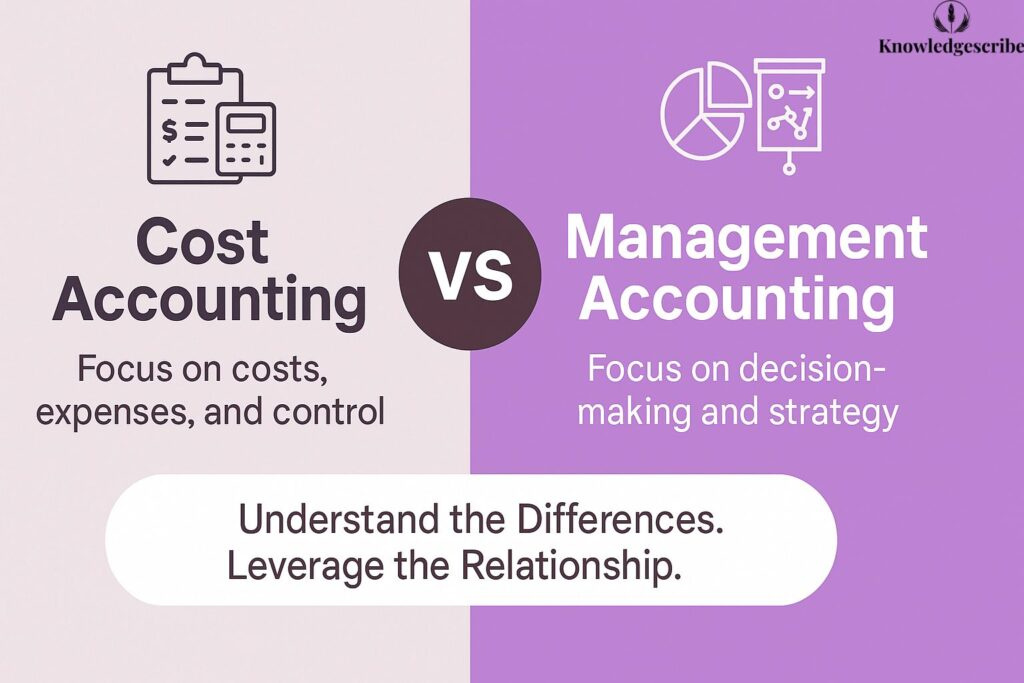Relationship Between Cost Accounting and Management Accounting
In the world of business decision-making, Cost Accounting and Management Accounting are two key branches of accounting that serve internal purposes. While they often overlap, they have distinct focuses and roles.
Cost Accounting is primarily concerned with calculating, recording, and analyzing the costs of production or services. Its main goal is to help businesses control costs and improve efficiency by tracking where and how money is spent.
On the other hand, Management Accounting is broader in scope. It uses both financial and non-financial information—including data from cost accounting—to assist managers in planning, decision-making, and performance evaluation.
In essence, Cost Accounting is more about cost control and analysis, while Management Accounting focuses on using that and other information to guide strategic and operational decisions.
How They Complement Each Other
Cost accounting and management accounting might seem like distinct entities, but they actually complement each other more than they compete. In any business setup, both systems work hand-in-hand to provide a comprehensive picture of financial health and internal efficiency. Cost accounting provides the raw data – the detailed breakdowns of costs per unit, department, project, or process. Management accounting, on the other hand, takes that data, analyzes it, and transforms it into actionable insights.
For example, if cost accounting reveals a rise in production costs over the last quarter, management accounting would dig deeper, compare it with output levels, and evaluate the profitability margins. Then, it would advise management on potential strategies – whether to reduce wastage, renegotiate supplier contracts, or invest in more efficient machinery.
Management accountants heavily rely on accurate cost accounting data to prepare budgets, forecasts, and performance reports. Without cost accounting feeding the numbers, management accounting would lack the factual foundation needed for accurate decision-making.
A Symbiotic Relationship Between Cost Accounting and Management Accounting
Think of cost accounting as the engine that churns out financial fuel and management accounting as the GPS guiding a business vehicle. Without the engine, there’s no power; without the GPS, there’s no direction. Their relationship is symbiotic – each strengthens the other.
Management decisions such as pricing, outsourcing, cost-cutting, or investing in new technology require solid cost information. Conversely, the data gathered for managerial purposes can loop back and refine cost accounting practices, making them more focused and aligned with strategic business objectives.
So, while they may be classified differently in accounting literature, in practice, their boundaries are often blurred. Companies that treat them as a unified system rather than separate silos usually experience better operational clarity and profitability.
Must Read : Best College for Company Secretary in India
Cost and Management Accounting for Decision Making
Cost and Management Accounting play a vital role in effective business decision-making. By analyzing costs, revenues, and operational data, they provide managers with the insights needed to plan, control, and evaluate performance. Cost accounting focuses on identifying and controlling production or service costs, helping businesses improve efficiency and reduce waste. Management accounting goes further by using both financial and non-financial information to support strategic planning, budgeting, and forecasting. Together, they enable informed decisions on pricing, investment, resource allocation, and overall business strategy, ultimately contributing to improved profitability and organizational success. Their relevance spans all industries and business sizes.
Role in Strategic and Operational Decisions
One of the primary purposes of both cost and management accounting is to aid in effective decision-making. These systems arm business leaders with facts, figures, and forecasts that form the bedrock of strategic planning.
Let’s break it down: cost accounting provides a granular view of where money is being spent – on materials, labor, overheads, etc. This enables organizations to identify areas of wastage, assess cost-effectiveness, and ensure proper resource allocation. For instance, knowing the cost per unit of production helps managers price their products competitively while maintaining healthy profit margins.
On the flip side, management accounting uses that cost data, integrates it with market trends, competitor analysis, and internal performance metrics, and then supports decisions related to budgeting, forecasting, investment planning, and performance evaluation.
Say a company is considering expanding into a new market. Management accounting will create projections based on past data, evaluate the financial risks, assess the required investments, and predict the break-even point – all while using cost accounting reports as the foundation.
Empowering Tactical Choices
At an operational level, cost and management accounting drive tactical decisions. Should the company buy or make a component? Which department is underperforming? How can overheads be controlled without affecting productivity? These questions are answered using the tools of variance analysis, break-even analysis, cost-volume-profit analysis, and standard costing – all of which stem from the union of cost and management accounting.
Ultimately, both systems empower managers at all levels to make choices that lead to leaner operations, improved profitability, and sustained business growth. The real magic lies in how they translate numbers into narratives – telling the financial story behind every business move.
Customers of Cost and Management Accounting
The primary customers of Cost and Management Accounting are internal users within an organization. These include managers at all levels—operational, tactical, and strategic—who rely on accurate cost data and performance reports to make informed decisions. Department heads use this information for budgeting and cost control, while senior executives utilize it for strategic planning and resource allocation. Additionally, project managers, production supervisors, and financial analysts depend on management accounting insights to optimize efficiency and profitability. Though external users like investors or regulators typically refer to financial accounting, cost and management accounting serve as essential tools for internal business decision-making.
Internal Stakeholders as Primary Users
Unlike financial accounting, which caters to external parties like shareholders, regulators, and tax authorities, cost and management accounting primarily serve internal stakeholders. Their customers are the managers, department heads, team leaders, and executives who run the day-to-day and long-term operations of a business.
These users rely on cost and management accounting to answer essential business questions. What’s our current profit margin? Where are we overspending? Which products are underperforming? Should we invest in automation? Should we launch a new product line? These insights can’t come from generic financial statements – they come from the granular analysis provided by cost and management accounting.
Specialized Reports for Specific Roles
Each level of management demands a different type of report:
Top Management receives strategic reports, forecasts, and profitability analyses that aid in high-level planning and investment decisions.
Middle Management benefits from budget reports, performance evaluations, and variance analyses to track departmental or product line performance.
Operational Managers use daily cost sheets, standard cost reports, and efficiency metrics to ensure everything runs smoothly on the ground.
Even HR, marketing, and R&D departments benefit. HR can assess the cost-effectiveness of employee benefit programs, while marketing can analyze campaign ROI using cost data. R&D teams can calculate project feasibility through cost-benefit analyses derived from these systems.
So, in essence, every decision-maker inside an organization is a customer of cost and management accounting. Their roles may vary, but their need for accurate, timely, and relevant financial insight remains constant.
Introduction to Financial Accounting, Cost Accounting, and Management Accounting
Accounting is the language of business, and it encompasses several branches, each serving distinct purposes. Financial Accounting focuses on recording, summarizing, and reporting a company’s financial transactions for external stakeholders such as investors, creditors, and regulatory bodies. It follows standardized rules like GAAP or IFRS to ensure consistency and comparability.
Cost Accounting deals with the collection, analysis, and control of production or service costs. Its goal is to help businesses understand cost structures and improve efficiency.
Management Accounting uses financial and non-financial data—including cost information—to assist internal decision-makers in planning, controlling, and strategizing for business success.
The Accounting Trifecta Explained
To get a complete picture, let’s examine how financial accounting, cost accounting, and management accounting fit together. These three branches of accounting serve different purposes but often interconnect in business.
Financial Accounting is the most externally focused. It deals with preparing reports like balance sheets, income statements, and cash flow statements – all adhering to legal standards and used by investors, creditors, and regulators.
Cost Accounting dives deep into internal operations. It captures the cost of production, processes, and projects to help managers understand spending patterns and control expenses.
Management Accounting takes a broader, more strategic view. It includes data from both cost and financial accounting and blends it with external market info, industry benchmarks, and internal KPIs to shape business strategy.
A Unified Framework for Better Business Decisions
In practical terms, these branches are like gears in a clock. Financial accounting keeps the business compliant and transparent. Cost accounting ensures operations are efficient and cost-effective. Management accounting charts the path ahead by analyzing past and present trends to forecast the future.
When a company integrates all three seamlessly, it creates a powerful financial intelligence system that supports long-term growth, competitive advantage, and sustainable profitability.
Key Differences Between Cost Accounting and Management Accounting with Examples
Here’s comparison of key differences between Cost Accounting and Management Accounting with examples:
| Aspect | Cost Accounting | Management Accounting |
|---|---|---|
| Purpose | To calculate, control, and reduce costs | To support planning, decision-making, and performance evaluation |
| Scope | Narrow – focuses mainly on cost analysis | Broad – includes budgeting, forecasting, financial analysis, etc. |
| Users | Mainly operational managers and cost controllers | All levels of management |
| Focus | Past and present cost data | Past, present, and future business performance |
| Regulation | Often follows internal costing standards | Not regulated by external standards |
| Tools Used | Cost sheets, job costing, process costing | Budgets, variance analysis, KPIs, balanced scorecards |
| Output Type | Detailed cost reports | Analytical and strategic reports |
| Example | Calculating the cost to manufacture one unit of a product | Analyzing whether to expand into a new market based on cost-profit analysis |
Understanding Through Real-World Scenarios
Let’s move beyond the theory and dive into practical examples to make the differences crystal clear. This approach not only helps understand the concepts better but also illustrates how each accounting method plays its own unique role in the business ecosystem.
Example 1: Manufacturing Firm
Cost Accounting Scenario: A manufacturing company wants to know the exact cost of producing one unit of its product. Cost accounting comes into play by recording direct materials, direct labor, and factory overheads to arrive at the total cost per unit.
Management Accounting Scenario: The same company wants to expand into a new market. Management accounting takes the unit cost from cost accounting and combines it with competitor pricing, market trends, and internal capacity to forecast profitability and ROI for the expansion.
Example 2: Budget Control
Cost Accounting focuses on tracking the actual cost versus the budgeted cost and identifies variances. For instance, if labor costs exceed expectations, cost accounting will highlight the deviation.
Management Accounting analyzes why the labor costs exceeded the budget and suggests steps – like automating part of the production line or renegotiating labor contracts – to control future costs.
Cost Accounting and Management Accounting Differences with Examples
Cost accounting focuses on tracking costs (e.g., product costing), while management accounting aids decisions (e.g., budgeting, performance analysis).
| Aspect | Cost Accounting | Management Accounting |
|---|---|---|
| Focus | Product/process cost tracking | Strategic business decisions |
| Data Type | Historical, transactional | Analytical, forward-looking |
| Example | Calculating cost per unit | Forecasting product line profitability |
| Reporting | Regular, detailed cost reports | Periodic strategic summaries |
| Audience | Cost controllers, accountants | Business managers, executives |
While both disciplines work toward financial clarity, their tools, techniques, and end goals differ significantly. One is about counting the coins; the other is about making the coins multiply.
Cost Accounting vs Management Accounting
To make the comparison even more digestible, here’s a detailed table that captures the nuances:
| Basis | Cost Accounting | Management Accounting |
|---|---|---|
| Definition | Records, classifies, and summarizes cost data to control and reduce expenses. | Provides financial and non-financial information for managerial decision-making. |
| Objective | Ascertainment and control of cost. | Planning, forecasting, and decision support. |
| Scope | Limited to cost data only. | Broader – includes cost, financial, and economic data. |
| Data Nature | Mostly historical. | Historical, current, and future-oriented. |
| Reporting Time | Regular and routine. | As required by management. |
| User | Internal (cost controllers, finance teams). | Internal (managers, executives). |
| Legal Requirement | Mandatory for some industries. | Not legally mandated. |
| Tools Used | Standard costing, marginal costing, variance analysis. | Budgeting, forecasting, financial modeling, ratio analysis. |
| Decision-Making Role | Supports operational efficiency. | Supports strategic and tactical planning. |
This structured comparison helps you instantly identify where the two disciplines diverge. Whether you’re a student, manager, or entrepreneur, this clarity is essential for applying the right methods in the right context.
Definitions of Cost Accounting and Management Accounting
Cost Accounting : Cost Accounting is the process of recording, classifying, analyzing, and allocating costs associated with a product, service, or process. Its primary aim is to determine the actual cost of operations and help in cost control and reduction.
Management Accounting : Management Accounting involves the preparation and use of financial and non-financial information to assist managers in planning, decision-making, performance evaluation, and strategic control. It supports internal business needs rather than external reporting.
Cost Accounting and Management Accounting Definitions by Experts
Here are a few expert definitions to provide a professional edge:
Chartered Institute of Management Accountants (CIMA) defines management accounting as:
“The process of identification, measurement, accumulation, analysis, preparation, interpretation, and communication of information used by management to plan, evaluate, and control within an organization.”Institute of Cost Accountants of India (ICAI) defines cost accounting as:
“The technique and process of ascertaining costs.”
These definitions underline how both disciplines serve different functions while being integral to the internal financial management of a business.
Difference Between Financial Accounting, Cost Accounting, and Management Accounting
Cost accounting tracks and analyzes production costs to improve efficiency. Management accounting uses financial and non-financial data to help managers plan, control, and make strategic business decisions.
Triangular Framework of Business Accounting
Each of these three accounting branches serves a unique role:
Financial Accounting: Designed primarily for external reporting. It summarizes the financial performance and position of an organization through statements like the Profit & Loss account and Balance Sheet.
Cost Accounting: Focused internally, it zeroes in on cost efficiency and controls. It helps businesses identify and manage their production and operational costs.
Management Accounting: Also internally focused but broader in scope. It supports management in making informed decisions, planning the future, and steering the business strategically.
Financial Accounting and Cost Accounting and Management Accounting Comparison
| Category | Financial Accounting | Cost Accounting | Management Accounting |
|---|---|---|---|
| Primary Focus | External reporting | Cost control and efficiency | Managerial decision-making |
| Users | Shareholders, banks, regulators | Internal departments | Managers and executives |
| Legal Obligation | Mandatory | Sometimes mandatory | Optional |
| Data Nature | Historical | Historical, quantitative | Historical + Forecasting |
| Reporting Format | Standardized | Flexible | Highly customizable |
Understanding this trio is like understanding the complete financial nervous system of a company. Each branch plays its part in ensuring financial clarity, control, and foresight.
Cost and Management Accounting in Hindi – Basic Concepts Explained
कॉस्ट और मैनेजमेंट अकाउंटिंग व्यवसाय में लागत नियंत्रण, योजना और निर्णय लेने में सहायक होते हैं। ये आंतरिक प्रबंधन को डेटा और विश्लेषण के आधार पर निर्णय लेने में मदद करते हैं।
हिंदी में कॉस्ट अकाउंटिंग और मैनेजमेंट अकाउंटिंग की व्याख्या
Cost accounting और management accounting के बीच अंतर को अगर सरल हिंदी में समझाया जाए, तो यह कहना ठीक होगा कि:
कॉस्ट अकाउंटिंग (Cost Accounting) एक ऐसी प्रक्रिया है, जिसमें उत्पादन या सेवाओं की लागत को रिकॉर्ड, वर्गीकृत और विश्लेषित किया जाता है। इसका मुख्य उद्देश्य यह होता है कि उत्पाद को बनाने में कितना खर्च आ रहा है और उस खर्च को कैसे नियंत्रित किया जाए।
मैनेजमेंट अकाउंटिंग (Management Accounting) प्रबंधन को निर्णय लेने, योजनाएं बनाने, और भविष्य की रणनीतियों को निर्धारित करने के लिए जरूरी वित्तीय और गैर-वित्तीय डेटा प्रदान करता है। इसमें सिर्फ लागत ही नहीं, बल्कि मार्केट ट्रेंड्स, प्रतिस्पर्धी विश्लेषण और बजट प्लानिंग भी शामिल होती है।
कॉस्ट अकाउंटिंग और मैनेजमेंट अकाउंटिंग उदाहरण
उदाहरण: एक कंपनी को जानना है कि एक यूनिट प्रोडक्ट बनाने में कितना खर्च आ रहा है – यह कॉस्ट अकाउंटिंग की मदद से तय होता है। अब कंपनी उस डेटा का उपयोग कर के निर्णय लेना चाहती है कि उस प्रोडक्ट को बाजार में किस कीमत पर बेचा जाए – यह काम मैनेजमेंट अकाउंटिंग करती है।
कॉस्ट अकाउंटिंग और मैनेजमेंट अकाउंटिंग प्रमुख अंतर (Key Differences in Hindi)
| आधार | कॉस्ट अकाउंटिंग | मैनेजमेंट अकाउंटिंग |
|---|---|---|
| उद्देश्य | लागत को नियंत्रित करना | निर्णय लेने में सहायता करना |
| उपयोगकर्ता | उत्पादन/फाइनेंस विभाग | प्रबंधन स्तर के अधिकारी |
| डेटा का प्रकार | ऐतिहासिक डेटा | ऐतिहासिक + भविष्य उन्मुख डेटा |
| रिपोर्टिंग | नियमित | आवश्यकता अनुसार |
| कानूनी आवश्यकता | कुछ इंडस्ट्री में अनिवार्य | कानूनी रूप से अनिवार्य नहीं |
Importance of Cost and Management Accounting in Modern Business
Cost and Management Accounting is crucial in modern business for controlling costs, optimizing resources, strategic planning, and informed decision-making, leading to improved efficiency, competitiveness, and overall business success.
Why These Systems Matter More Than Ever
In the age of digital transformation, global competition, and razor-thin margins, businesses need more than just a balance sheet to survive and thrive. That’s where cost and management accounting become indispensable.
These systems allow businesses to:
Pinpoint inefficiencies
Reduce waste and unnecessary expenses
Set competitive pricing without compromising profits
Forecast future demand and performance
Make informed, strategic decisions based on real-time data
For example, a retail company can use cost accounting to determine the exact cost of goods sold (COGS), and then use management accounting to decide which products to promote based on margin analysis and seasonal trends.
Moreover, in industries like healthcare, manufacturing, logistics, and software, where operational complexity is high, the integration of cost and management accounting often becomes the key differentiator between success and failure.
Real-Time Data, Real-Time Decisions
In today’s fast-paced business environment, delay in decision-making can cost companies millions. Management accounting, fueled by up-to-date cost accounting data, helps leaders make fast, data-driven decisions.
Whether it’s launching a new product, closing an underperforming branch, or restructuring the workforce, cost and management accounting play a frontline role in shaping these decisions with data and confidence.
Career Opportunities in Cost and Management Accounting
Cost and Management Accounting helps modern businesses control costs, improve efficiency, support strategic planning, and make informed decisions, ultimately enhancing profitability, competitiveness, and long-term sustainability in a dynamic market.
High Demand, High Value Careers
If you’re considering a career in accounting, cost and management accounting open doors to diverse industries and high-impact roles. Here’s what makes them attractive:
Job Roles Include: Cost Accountant, Management Accountant, Budget Analyst, Financial Planner, Controller, CFO
Industries Hiring: Manufacturing, Banking, Consulting, FMCG, Healthcare, IT, Government
Skills in Demand: Financial modeling, variance analysis, budgeting, ERP software proficiency (SAP, Oracle), strategic planning
As businesses grow in size and complexity, the demand for professionals who can interpret cost structures and support strategic decisions continues to surge.
Education and Certification
To pursue a career, you might consider:
CMA (Certified Management Accountant)
ICMAI (India-specific Cost & Management Accountant)
CPA, ACCA, MBA in Finance (with specialization in cost or management accounting)
With growing global business complexity, cost and management accounting professionals are not just back-office accountants anymore – they’re strategic partners in value creation.
Tools and Techniques Used in Cost and Management Accounting
Tools and techniques in Cost and Management Accounting include budgeting, standard costing, variance analysis, marginal costing, break-even analysis, ratio analysis, cost-volume-profit analysis, and performance measurement systems.
Must-Know Tools for Professionals and Students
Both cost and management accounting utilize a wide range of techniques to deliver results:
Cost Accounting Tools
Standard Costing
Marginal Costing
Activity-Based Costing (ABC)
Job Order Costing
Process Costing
Management Accounting Tools
Budgeting and Budgetary Control
Forecasting Techniques
Variance Analysis
Balanced Scorecard
Break-even Analysis
Financial Ratios and Trend Analysis
Technology Integration
With the rise of software like SAP, Tally, QuickBooks, and Oracle, both cost and management accounting have become more efficient and data-driven. These platforms automate data collection, reduce manual errors, and produce real-time reports.
Emerging trends also include:
AI-based forecasting tools
Dashboards and data visualization software (Power BI, Tableau)
Cloud accounting platforms
Businesses investing in these tools not only improve their financial accuracy but also speed up decision-making cycles dramatically.
Cost accounting and management accounting are two of the most critical internal tools businesses use to operate efficiently and plan for the future. While cost accounting focuses on measuring and controlling costs, management accounting looks at the broader picture – guiding strategy and decisions. Understanding their roles, differences, and interdependence helps businesses and professionals align their goals with real-time insights and long-term strategies.
Whether you’re a student, a business owner, or a finance professional, mastering both disciplines will give you a competitive edge in today’s fast-evolving financial world.
”FAQs”
1. What is the main difference between cost accounting and management accounting?
Cost accounting deals with cost control and measurement, while management accounting helps in planning and strategic decision-making using financial and non-financial information.
2. Can a company operate with only one of these accounting systems?
It’s possible but not ideal. Cost accounting gives precise cost data, but without management accounting, a company lacks the ability to make strategic decisions using that data.
3. Is cost accounting legally required?
Yes, in certain industries like manufacturing, it is mandatory to maintain cost records as per government regulations.
4. What qualifications are required for a career in cost and management accounting?
Degrees like B.Com, M.Com, CMA, CPA, ACCA, or MBA with finance specialization are commonly pursued by professionals in this field.
5. Are financial accounting and management accounting the same?
No. Financial accounting is for external stakeholders and follows strict guidelines, while management accounting is flexible and designed for internal use.







